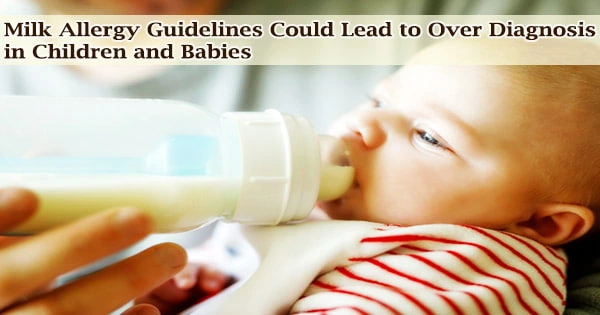Over-diagnosis of cow’s milk allergy in newborns and young children may be linked to current medical recommendations for detecting the ailment. This is the conclusion of a recent study conducted by Imperial College London and Moscow’s Sechenov University.
The study discovered that roughly 1% of children have cow’s milk allergy, but up to 14% of families assume their child has the ailment, according to the paper, which was published in the journal JAMA Pediatrics.
Official standards for diagnosing cow’s milk allergy, according to the study, could be to blame for the overdiagnosis. The researchers looked at nine official cow’s milk allergy guidelines that were released between 2012 and 2019.
These recommendations came from a variety of medical organizations across a number of nations, mostly in Europe. Many of the guidelines, the researchers discovered, included symptoms like frequent weeping, regurgitating milk, and loose feces as signs of cow’s milk allergy, but the authors claim that these symptoms are fairly typical in normal, healthy babies.
In a recent European birth cohort study involving over 12,000 infants from nine nations, the researchers discovered that less than 1% of the children had a cow’s milk allergy. However, they discovered that up to 14% of families feel their infant has a cow’s milk allergy in various research.
Furthermore, the data reveals that between 2000 and 2018, the prescription of specialty formulas for babies with cow’s milk allergy increased dramatically in nations such as Australia and England, despite no indication of a rise in cow’s milk allergy.
The researchers looked at how many authors of the recommendations had disclosed a conflict of interest with formula producers and discovered that eight out of every ten authors had declared a conflict of interest. Seven of the nine guidelines urged breastfeeding mothers to eliminate all dairy from their diet if their infant had a suspected cow’s milk allergy, according to the researchers.
Formula manufacturers may gain from promoting increased cow’s milk allergy diagnosis by influencing practitioners and parents to use a specialized formula in place of a cheaper formula, and by potentially undermining women’s confidence in breastfeeding, so that specialized formula is used in place of breast milk.
Dr. Robert Boyle
However, based on their review of 13 studies of breast milk composition, less than one-millionth of the protein from cow’s milk makes it to breast milk, which is too tiny to cause an allergic reaction in most allergic infants.
Dr. Robert Boyle, Consultant Allergy Specialist and lead author of the research from Imperial’s National Heart and Lung Institute, explained:
“Many infants who are labelled as having milk allergy don’t have the condition. Having a child with a suspected milk allergy can be a stressful time for any family. Misdiagnosing milk allergy could lead to another condition with similar symptoms being missed, or breastfeeding mothers needlessly following restricted diets or even stopping breastfeeding altogether. It can also lead to families and the NHS unnecessarily paying for expensive specialist formula.”
Milk allergy is most common in children under the age of two, and it is divided into two types: IgE-mediated and non-IgE-mediated. IgE-mediated reactions involve a component of the immune system called IgE, and symptoms such as vomiting, hives, and, in extremely rare situations, anaphylaxis (severe allergic reaction causing difficulty breathing).
Vomiting, diarrhoea, and excessive sobbing are some of the signs of non-IgE mediated responses. The team does note out, however, that because of the nature of these symptoms, they are frequently confused with normal signs in newborn babies.
Dr. Daniel Munblit, Associate Professor of Paediatrics from Sechenov University and first author of the paper, explained:
“In the nine guidelines we studied, seven of them suggested including milder symptoms as indication of non-IgE cow’s milk allergy, such as regurgitating milk, crying, and rashes but many of these symptoms are present normally in babies, and will get better with time. Non-IgE cow’s milk allergy affects less than 1 percent of infants whereas troublesome vomiting, crying or eczema each affect 15-20 percent of babies.”
The researchers looked at data on the level of beta-lactoglobulin, a type of cow’s milk protein that has been linked to allergic reactions. The amount of this protein in breast milk was just micrograms (millionths of a gram) per liter, according to their findings.
For almost 99 percent of children with cow’s milk allergy, this amount is too little to cause a reaction during breastfeeding, according to the researchers.
Three guidelines were directly backed by formula makers or marketing consultants, according to the researchers, and 81 percent of all guideline writers indicated a conflict of interest with formula producers.
Receiving funding from a corporation that stands to profit from the advice in the guideline is considered a conflict of interest.
Dr. Boyle explained: “Formula manufacturers may gain from promoting increased cow’s milk allergy diagnosis by influencing practitioners and parents to use a specialized formula in place of a cheaper formula, and by potentially undermining women’s confidence in breastfeeding, so that specialized formula is used in place of breast milk.”
He added: “We must not only critically appraise our current guidelines, and dissociate the development of guidelines from those who may profit from them, but also ensure we are giving each family the best possible care by avoiding over diagnosis of cow’s milk allergy.”





